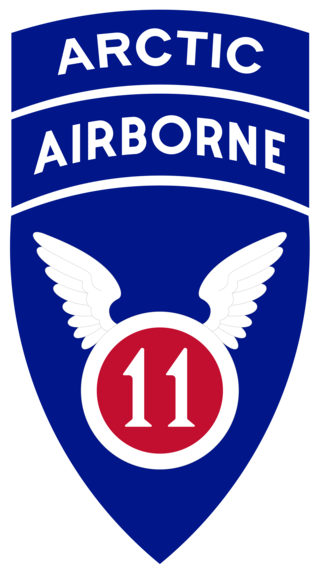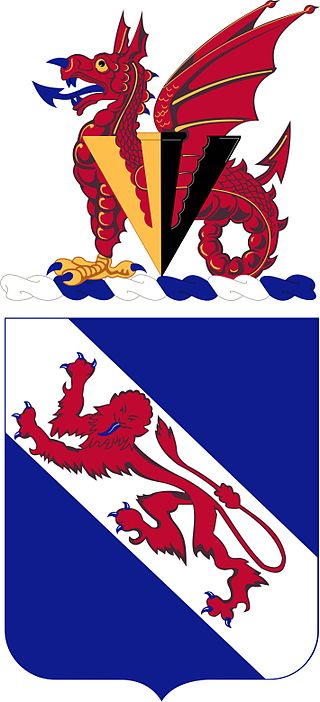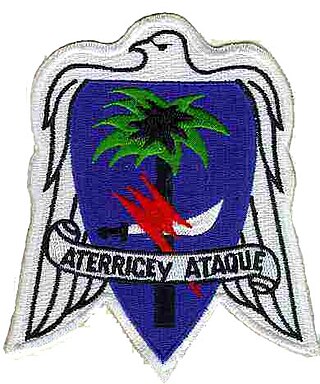
Airborne forces are ground combat units carried by aircraft and airdropped into battle zones, typically by parachute drop. Parachute-qualified infantry and support personnel serving in airborne units are also known as paratroopers.

The 82nd Airborne Division is an airborne infantry division of the United States Army specializing in parachute assault operations into denied areas with a U.S. Department of Defense requirement to "respond to crisis contingencies anywhere in the world within 18 hours". Based at Fort Liberty, North Carolina, the 82nd Airborne Division is part of the XVIII Airborne Corps. The 82nd Airborne Division is the U.S. Army's most strategically mobile division.

The 11th Airborne Division is a United States Army airborne formation based in Alaska.

The 13th Airborne Division was an airborne forces formation of division-size of the United States Army that was active during World War II. The division was commanded for most of its existence by Major General Elbridge G. Chapman. It was officially activated in the United States in August 1943 at Fort Bragg in North Carolina, remaining active until February 1946, however it never saw combat.

The 17th Airborne Division, "The Golden Talons", was an airborne infantry division of the United States Army during World War II, commanded by Major General William M. Miley.

In military organizations, a pathfinder is a specialized soldier inserted or dropped into place in order to set up and operate drop zones, pickup zones, and helicopter landing sites for airborne operations, air resupply operations, or other air operations in support of the ground unit commander. Pathfinders first appeared in World War II, and continue to serve an important role in today's modern armed forces, providing commanders with the option of flexibly employing air assets.

The 187th Airborne Infantry Regiment (Rakkasans) is a regiment of the 101st Airborne Division.

The 517th Parachute Infantry Regiment was an airborne infantry regiment of the United States Army, formed during World War II. At times the regiment was attached to the 17th Airborne Division, 82nd Airborne Division and later, the 13th Airborne Division. During most of their combat, the unit was an independent combined force of 17th Airborne troops called the 517th Parachute Regimental Combat Team or 517th PRCT /517th PCT /517th RCT.

The 508th Infantry Regiment is an airborne infantry regiment of the United States Army, first formed in October 1942 during World War II. The 508th is a parent regiment under the U.S. Army Regimental System, and two battalions from the regiment are currently active: the 1st Battalion, 508th Parachute Infantry Regiment is assigned to the 3rd Brigade Combat Team, 82nd Airborne Division, and the 2nd Battalion, 508th Parachute Infantry Regiment is assigned to the 2nd Brigade Combat Team, 82nd Airborne Division. The regiment served in combat during World War II, and regimental elements have served in combat in the Dominican Republic, Vietnam, Grenada, Panama, Iraq and Afghanistan.

The United States Army Airborne School—widely known as Jump School—conducts the basic paratrooper training for the United States Armed Forces. It is operated by the 1st Battalion (Airborne), 507th Infantry, United States Army Infantry School, Fort Moore, Georgia. The Airborne School conducts the Basic Airborne Course, which is open to troops from all branches of the United States Department of Defense, Reserve Officer Training Corps, and allied military personnel.

The 517th Parachute Regimental Combat Team was an airborne, specifically a parachute infantry, regiment of the United States Army that was formed in March 1943 during World War II, training at Camp Toccoa in the mountains of Northeast Georgia.

The 504th Infantry Regiment, originally the 504th Parachute Infantry Regiment, is an airborne forces regiment of the United States Army, part of the 82nd Airborne Division, with a long and distinguished history. The regiment was first formed in mid-1942 during World War II as part of the 82nd Airborne Division and saw service in Sicily, Italy, Anzio, the Netherlands, Belgium and Germany.

The 501st Infantry Regiment, previously the 501st Parachute Infantry Regiment and 501st Airborne Infantry Regiment, is an airborne forces regiment of the United States Army with a long history, having served in World War II and the Vietnam War, both as part of the 101st Airborne Division, as well as the War in Afghanistan. It is the first airborne unit by designation in the United States Armed Forces. Its 1st Battalion is assigned to the 2nd Infantry Brigade Combat Team (Airborne), 11th Airborne Division, located at Fort Richardson, Alaska. Its 2nd Battalion is assigned to the 1st Brigade Combat Team, 82nd Airborne Division, located at Fort Liberty, North Carolina.

American airborne landings in Normandy were a series of military operations carried by the United States as part of Operation Overlord, the invasion of Normandy by the Allies on June 6, 1944 during World War II. Approximately 13,100 American paratroopers from the 82nd and 101st Airborne Divisions conducted parachute drops, followed by 3,937 glider infantrymen, on June 6. As the opening maneuver of the Normandy landings, the two American airborne divisions were dropped in Normandy via two parachute and six glider missions.
Mission Boston was a parachute combat assault at night by Major General Matthew Ridgway's U.S. 82nd Airborne Division on June 6, 1944, part of the American airborne landings in Normandy during World War II. Boston was a component element of Operation Neptune, the assault portion of the Allied invasion of Normandy, codenamed Operation Overlord. 6,420 paratroopers jumped from nearly 370 C-47 Skytrain troop carrier aircraft into an intended objective area of roughly 10 square miles (26 km2) located on either side of the Merderet river on the Cotentin Peninsula of France, five hours ahead of the D-Day landings.

In the United States (US) military, a beret flash is a shield-shaped embroidered cloth that is typically 2.25 in (5.72 cm) tall and 1.875 in (4.76 cm) wide with a semi–circular base that is attached to a stiffener backing of a military beret. These flashes—a British English word for a colorful cloth patch attached to military headgear—are worn over the left eye with the excess cloth of the beret shaped, folded, and pulled over the right ear giving it a distinctive appearance.

The 551st Parachute Infantry Battalion was, for many years, a little-recognized airborne forces unit of the United States Army, raised during World War II, that fought in the Battle of the Bulge. Originally commissioned to take the French Caribbean island of Martinique, they were shipped instead to Western Europe. With an initial strength of 800 officers and enlisted men, the remaining 250 members of the Battalion were ordered on 7 January 1945 to attack the Belgian village of Rochelinval over open ground and without artillery support. During the successful assault the unit lost more than half its remaining men. The Battalion was inactivated on 27 January 1945 and the remaining 110 survivors were absorbed into the 82nd Airborne Division. Virtually nothing of the unit's history was known to the American public until the 1990s when renewed interest prompted its veterans to seek recognition for their costly success at Rochelinval. The battalion was awarded a Presidential Unit Citation in 2001 recognizing its accomplishment.
The 542nd Parachute Infantry Regiment was a regiment of the US Army during the World War II. Originally formed as a fully fledged regiment, the unit was later downsized to a battalion and kept in reserve in the United States until mid-1945 when it was deactivated.
The 515th Parachute Infantry Regiment was an airborne, specifically a parachute infantry, regiment of the United States Army during World War II. The unit was used to provide replacements for overseas, but was later assigned to the 13th Airborne Division and sent to the Western Front in anticipation of combat with the Germans and was later en route to the Pacific Theatre when the war came to an end.

The 326th Infantry Regiment was an infantry regiment of the United States Army that saw active service during World War I, as part of the 82nd Division and fought in the Meuse-Argonne Offensive and was inactivated in 1919. The regiment was reactivated during World War II, again as part of the 82nd Infantry Division, and was converted into a glider infantry formation, becoming the 326th Glider Infantry Regiment. Originally part of the 82nd Airborne Division, the regiment transferred to the 13th Airborne Division. However, despite training for almost three years, the 326th was never involved in any combat.

















